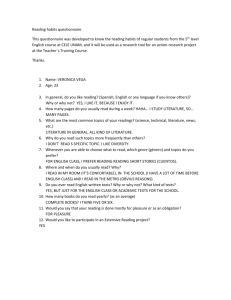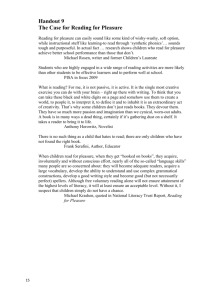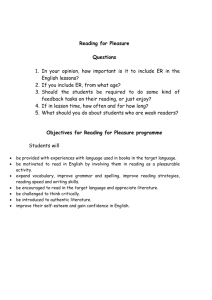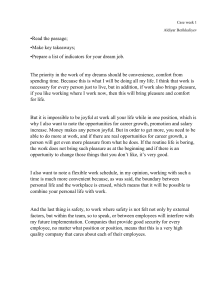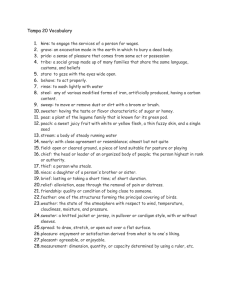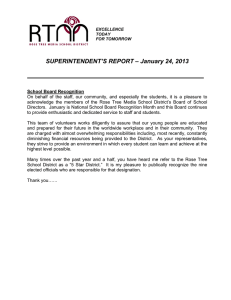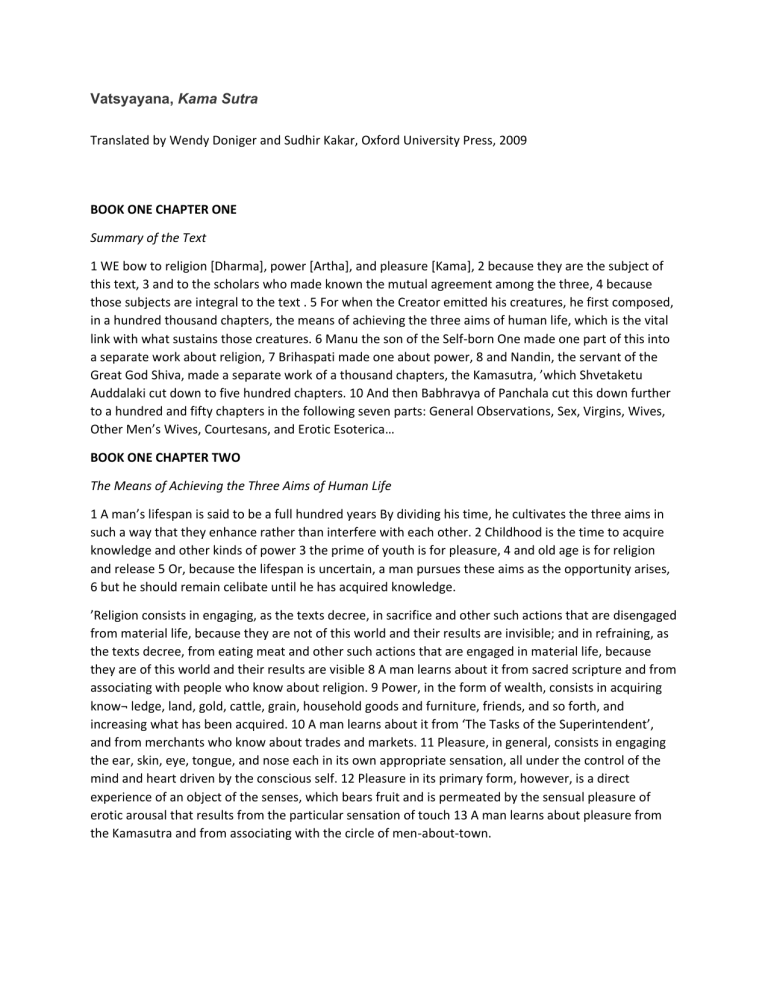
Vatsyayana, Kama Sutra Translated by Wendy Doniger and Sudhir Kakar, Oxford University Press, 2009 BOOK ONE CHAPTER ONE Summary of the Text 1 WE bow to religion [Dharma], power [Artha], and pleasure [Kama], 2 because they are the subject of this text, 3 and to the scholars who made known the mutual agreement among the three, 4 because those subjects are integral to the text . 5 For when the Creator emitted his creatures, he first composed, in a hundred thousand chapters, the means of achieving the three aims of human life, which is the vital link with what sustains those creatures. 6 Manu the son of the Self-born One made one part of this into a separate work about religion, 7 Brihaspati made one about power, 8 and Nandin, the servant of the Great God Shiva, made a separate work of a thousand chapters, the Kamasutra, ’which Shvetaketu Auddalaki cut down to five hundred chapters. 10 And then Babhravya of Panchala cut this down further to a hundred and fifty chapters in the following seven parts: General Observations, Sex, Virgins, Wives, Other Men’s Wives, Courtesans, and Erotic Esoterica… BOOK ONE CHAPTER TWO The Means of Achieving the Three Aims of Human Life 1 A man’s lifespan is said to be a full hundred years By dividing his time, he cultivates the three aims in such a way that they enhance rather than interfere with each other. 2 Childhood is the time to acquire knowledge and other kinds of power 3 the prime of youth is for pleasure, 4 and old age is for religion and release 5 Or, because the lifespan is uncertain, a man pursues these aims as the opportunity arises, 6 but he should remain celibate until he has acquired knowledge. ’Religion consists in engaging, as the texts decree, in sacrifice and other such actions that are disengaged from material life, because they are not of this world and their results are invisible; and in refraining, as the texts decree, from eating meat and other such actions that are engaged in material life, because they are of this world and their results are visible 8 A man learns about it from sacred scripture and from associating with people who know about religion. 9 Power, in the form of wealth, consists in acquiring know¬ ledge, land, gold, cattle, grain, household goods and furniture, friends, and so forth, and increasing what has been acquired. 10 A man learns about it from ‘The Tasks of the Superintendent’, and from merchants who know about trades and markets. 11 Pleasure, in general, consists in engaging the ear, skin, eye, tongue, and nose each in its own appropriate sensation, all under the control of the mind and heart driven by the conscious self. 12 Pleasure in its primary form, however, is a direct experience of an object of the senses, which bears fruit and is permeated by the sensual pleasure of erotic arousal that results from the particular sensation of touch 13 A man learns about pleasure from the Kamasutra and from associating with the circle of men-about-town. 14 When these three aims—religion, power, and pleasure— compete, each is more important than the one that follows. 15 But power, in the form of wealth, is the most important goal for a king—because it is the basis of social life—and for a courtesan * Those are the means of achieving the three aims. 16 Scholars say: ‘It is appropriate to have a text about religion, because it concerns matters not of this world, and to have one about power, because that is achieved only when the groundwork is laid by special methods, which one learns from a text. 17 But since even animals manage sex by themselves, and since it goes on all the time, it should not have to be handled with the help of a text.’ 18 Vatsyayana says: Because a man and a woman depend upon one another in sex, it requires a method, 19 and this method is learned from the Kamasutra. 20 The mating of animals, by contrast, is not based upon any method: because they are not fenced in, they mate only when the females are in their fertile season and until they achieve their goal, and they act without thinking about it first. BOOK ONE CHAPTER THREE Exposition of the Arts 1 A man should study the Kamasutra and its subsidiary sciences as long as this does not interfere with the time devoted to religion and power and their subsidiary sciences. 2 A woman should do this before she reaches the prime of her youth, and she should continue when she has been given away, if her husband wishes it. 3 Scholars say: ‘Since females cannot grasp texts, it is useless to teach women this text.’ 4 Vatsyayana says: But women understand the practice, and the practice is based on the text* 5 This applies beyond this specific subject of the Kamasutra, for throughout the world, in all subjects, there are only a few people who know the text, but the practice is within the range of everyone. 6 And a text, however far removed, is the ultimate source of the practice. 7 ‘Grammar is a science’, people say. Yet the sacrificial priests, who are no grammarians, know how to gloss the words in the sacrificial prayers* 8 ‘Astronomy is a science’, they say. But ordinary people perform the rituals on the days when the skies are auspicious. 9 And people know how to ride horses and elephants without studying the texts about horses and elephants. 10 * In the same way, even citizens far away from the king do not step across the moral line that he sets. The case of women learning the Kamasutra is like those examples. 11 And there are also women whose understanding has been sharpened by the text: courtesans de-luxe and the daughters of kings and ministers of state. 12 A woman should therefore learn the techniques and the text, or at least one part of it, from a trusted person, in private. 13 And alone, in private, a virgin should practise the sixty- four techniques that take practice. 14 15 But the people qualified to teach a virgin are: a foster-sister who grew up with her and has already made love with a man; or a girlfriend* who has had the same experience and with whom she can converse without risk; one of her mother’s sisters who is her age; an old servant woman who is trusted and can take that aunt’s place; a female renunciant with whom she has previously been intimate; and her own sister, if that sister takes her into her confidence about her own love-making. BOOK TWO CHAPTER NINE Oral Sex 1 There are two sorts of persons of the third nature, in the form of a woman and in the form of a man. 2 The one in the form of a woman imitates a woman’s dress, chatter, grace, emotions, delicacy, timidity, innocence, frailty, and bashfulness. 3 The act that should be done in the sexual organ is done in her mouth, and they call that ‘oral sex’*4 She gets her sexual pleasure and erotic arousal as well as her livelihood from this, 5 living like a courtesan. That is the person of the third nature in the form of a woman. 6 The one in the form of a man, however, conceals her desire when she wants a man and makes her living as a masseur. 7 As she massages the man, she caresses his two thighs with her limbs, as if she were embracing him. “Then she becomes more boldly intimate and familiar and touches the places where his thighs join his torso, and his sexual organ. 9 If she notices that he has become hard as a result of this, she stimulates him by using her hand as a churn, pretending to tease him about how easily he becomes excited and laughing at him. 10 If the man does not urge her on, even when he has given this clear sign and even when it is obvious that he is aroused, she makes advances to him on her own. 11 If the man urges her to go on, she argues with him and only unwillingly continues. 12 Oral sex involves eight acts, one after the other: 13 the ‘casual’, ‘biting the sides’, ‘the outer tongs’, ‘the inner tongs’, ‘kissing’, ‘polishing’, ‘sucking the mango’, and ‘swallowing’… Groaning and slapping may also be used, as they are called for. That is oral sex with a person of the third nature 25 Promiscuous women, loose women, servant girls, and masseuses also perform oral sex. 26 Scholars say: ‘But it should not be done, because it is opposed by the moral code and is not done in proper society, and because if a man has contact again with the mouth of these women, he himself may be troubled.’ 27 But Vatsyayana says: This is not a mistake for a man who loves courtesans, though it should also be avoided for other reasons. 28 Therefore people in the East (of India) do not make love with women who practise oral sex. 29 And the people of Ahichattra do not make love with courtesans, but when they do, they avoid the act of the mouth with these women. 30 The men of Saketa do not worry about anything when they make love. The men of the city do not indulge in oral sex themselves, 32 but the people of Surasena do everything, without the slightest hesitation. 33 For this is what they say: ‘For who can have any faith in women’s good character, purity, good behaviour, good practices, reliability, or words? For by their very nature they have a dirty gaze, but they need not be rejected. Therefore the religious tradition tells us to regard them as pure. And so they say: “A calf is unpolluted while the milk is flowing, as is a dog when it catches a wild animal, a bird when it knocks down a fruit, and a woman’s mouth in the ecstasy of sex.” ’ 34 Vatsyayana says: Since learned men disagree and there are discrepancies in what the religious texts say, one should act according to the custom of the region and one’s own disposition and confidence. 35 And there are verses about this: Even young men, servants who wear polished earrings, indulge in oral sex only with certain men. 36 And, in the same way, certain men-about-town who care for one another’s welfare and have established trust do this service for one another. 37 Sometimes men even perform this act upon women, transposing the procedure for kissing a mouth. Sometimes a man and woman may turn their bodies head to foot, so that they can make love to one another at the same time; and that is known as ‘sex in the manner of crows.’ 39 It is for this that courtesans reject virtuous, clever, generous men, and become attached to scoundrels, servants, elephantdrivers, and so forth. 40 But a wise Brahmin, or a minister of state or a man on whom the king depends or any man in whom people confide, should not indulge in oral sex. 41 For the statement that ‘There is a text for this’ does not justify a practice. People should realize that the contents of the texts apply in general, but each actual practice is for one particular region. 42 Medical science, for example, recommends cooking even dog meat, for juice and virility; but what intelligent person would eat it? 43 There are some men, and there are certain sorts of regions, and there are times when these practices are not without their uses. 44 Therefore, when a man has considered the region, and the time, and the technique, and the textbook teachings, and himself, he may—or may not—make use of these practices. 45 But because this matter is secret, and because the mind and heart are fickle, who could know who should do what, and when and how? BOOK 5 CHAPTER SIX The Life of the Women of the Harem of the King 1 The women of the harem cannot meet men, because they are carefully guarded; and since they have only one husband shared by many women in common, they are not satisfied. Therefore they give pleasure to one another with the following techniques. 2 They dress up a foster-sister or girlfriend or servant girl like a man and relieve their desire with dildos or with bulbs, roots, or fruits that have that form. 3 They lie on statues of men that have distinct sexual characteristics. 4 Kings, too, if they are sympathetic to their women even when their passion does not stir, make use of dildos until they achieve their goal, so that in one night they can even go to many women. But when the woman he loves has her turn to sleep with him or is in her fertile season, then the man acts out of desire. Those are the Oriental customs. 5 With the very same technique that women use, men, too, if they cannot get any sexual action, are said to relieve their desire in things other than the vagina, in creatures other than the human species, in statues of women, and by simple masturbation.) 6 The women of the harem generally get their women servants to bring in men-about-town dressed as women. 7- 9 Their foster-sisters, too, if they are intimate with the women on the inside, may make an effort to accost these men, showing them what a future there is in it. “They describe how easy it is to enter, the place where they can get out, the spaciousness of the building, the carelessness of the guards, and the irregularities of the entourage. “They should not, however, use false representations to get people to enter, for this would be a serious mistake. 10 Vatsyayana says: A man-about-town, however, should not enter a harem even if it is easy to get into, because this usually ends in disaster. 11 But if he has considered, with an eye to the rewards, all the factors—if the harem has an exit and is deeply hidden by thick woods, the wall enclosing the harem is long and divided up, the guards are few and careless, and the king is away—and if he has been invited many times, and he has worked out a way over the wall, and the women have shown him the way to do it, he may enter. 12 And within the realm of possibility, he should come out every day.

